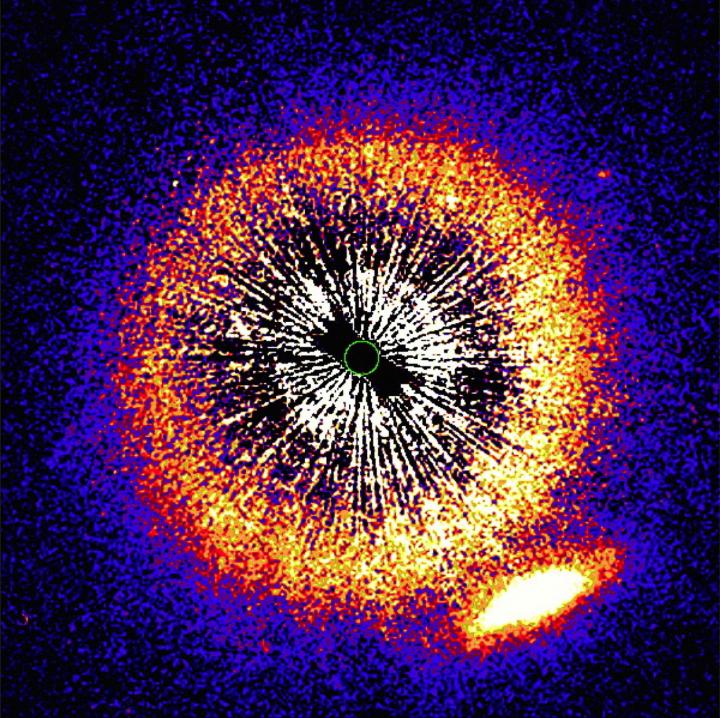Hubble 'traps' a vermin galaxy

This shows a distant galaxy -- visible as the smudge to the lower right -- as it begins to align with and pass behind a star sitting nearer to us within the Milky Way. This is an event known as a transit. The star is called HD 107146, and it sits at the center of the frame. Its light has been blocked in this image to make its immediate surroundings and the faint galaxy visible -- the position of the star is marked with a green circle. Credit: ESA/Hubble & NASA
This shows a distant galaxy — visible as the smudge to the lower right — as it begins to align with and pass behind a star sitting nearer to us within the Milky Way. This is an event known as a transit. The star is called HD 107146, and it sits at the center of the frame.
Its light has been blocked in this image to make its immediate surroundings and the faint galaxy visible — the position of the star is marked with a green circle.
The concentric orange circle surrounding HD 107146 is a circumstellar disk — a disk of debris orbiting the star. In the case of HD 107146 we see the disk face-on. As this star very much resembles our sun, it is an interesting scientific target to study: its circumstellar disk could be analogous to the asteroids in our Solar System and the Kuiper belt.
A detailed study of this system is possible because of the much more distant galaxy — nicknamed the “Vermin Galaxy” by some to reflect their annoyance at its presence — as the star passes in front of it.
The unusual pairing was first observed in 2004 by Hubble's Advanced Camera for Surveys, and again in 2011 by Hubble's Space Telescope Imaging Spectrograph.
The latter image is shown here, as the Vermin Galaxy began its transit behind HD 107146. The galaxy will not be fully obscured until around 2020, but interesting science can be done even while the galaxy is only partly obscured.
Light from the galaxy will pass through the star's debris disks before reaching our telescopes, allowing us to study the properties of the light and how it changes, and thus infer the characteristics of the disk itself.
Media Contact
All latest news from the category: Physics and Astronomy
This area deals with the fundamental laws and building blocks of nature and how they interact, the properties and the behavior of matter, and research into space and time and their structures.
innovations-report provides in-depth reports and articles on subjects such as astrophysics, laser technologies, nuclear, quantum, particle and solid-state physics, nanotechnologies, planetary research and findings (Mars, Venus) and developments related to the Hubble Telescope.
Newest articles

A new puzzle piece for string theory research
Dr. Ksenia Fedosova from the Cluster of Excellence Mathematics Münster, along with an international research team, has proven a conjecture in string theory that physicists had proposed regarding certain equations….

Climate change can cause stress in herring larvae
The occurrence of multiple stressors undermines the acclimatisation strategies of juvenile herring: If larvae are exposed to several stress factors at the same time, their ability to respond to these…

Making high-yielding rice affordable and sustainable
Plant biologists show how two genes work together to trigger embryo formation in rice. Rice is a staple food crop for more than half the world’s population, but most farmers…



